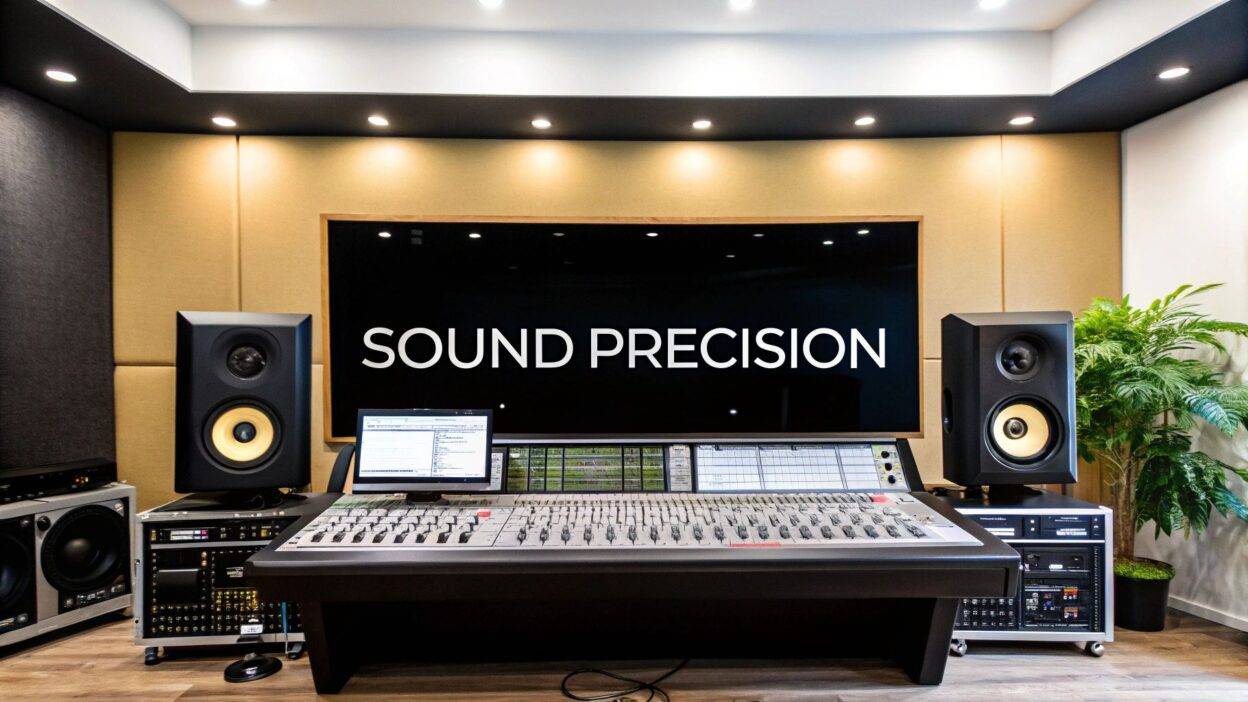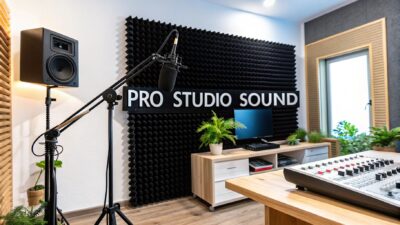Level Up Your Sound: Choosing the Right Monitors
Producing professional-sounding music at home hinges on accurate sound reproduction. This listicle presents eight of the best home studio monitors for 2025, helping you overcome inaccurate mixes caused by subpar listening environments. Whether you're a songwriter, producer, or independent artist, this curated list will guide you to the ideal monitors for your budget, revealing clear sonic detail within your home studio. From the Adam Audio A7V to the Neumann KH 120 II, find your perfect match. For more resources, explore ChordX, curated by industry expert Jimil.
1. Adam Audio A7V
For serious home studio owners seeking a professional monitoring solution, the Adam Audio A7V stands as a top contender among the best home studio monitors available. These powered nearfield monitors are designed to deliver pristine audio reproduction, making them an ideal choice for mixing, mastering, and critical listening. The A7V's combination of innovative technology and robust build quality ensures accurate sound representation, allowing you to make informed decisions during your production process. Whether you're an aspiring music producer, a seasoned songwriter, or an independent artist, the A7V offers a level of clarity and precision that can significantly elevate your work. These aren't just speakers; they're an investment in the future of your sound.

At the heart of the A7V's exceptional performance lies Adam Audio's proprietary X-ART Accelerated Ribbon Tweeter. This technology delivers incredibly detailed high-frequency reproduction, extending up to 50kHz. What this means in practical terms is that you’ll hear nuances and subtleties in your mixes that might be lost on lesser monitors. This clarity is crucial for tasks like EQing, where precise adjustments can make or break the final product. Complementing the X-ART tweeter is a 7-inch carbon fiber woofer, responsible for delivering tight, controlled bass frequencies. This combination ensures a balanced and accurate frequency response across the entire audible spectrum.
One of the standout features of the A7V is its sophisticated DSP-based room adaptation. Most home studios aren't acoustically perfect, and room reflections can significantly color the sound you hear. The A7V's room adaptation allows you to compensate for these imperfections by adjusting various parameters to optimize the monitor's performance in your specific listening environment. This feature is particularly beneficial for smaller spaces, where accurate low-frequency reproduction can be challenging. Through the onboard controls and software interface, you can tailor the A7V's response to minimize the negative impact of room modes and reflections, resulting in a more accurate and reliable monitoring experience.
Connectivity is another area where the A7V excels. With multiple analog and digital inputs (XLR, RCA, and AES3), these monitors integrate seamlessly into any studio setup. Whether you’re connecting directly from an audio interface or using a digital mixer, the A7V offers the flexibility you need. This versatility makes the A7V a future-proof investment, adaptable to evolving studio configurations and technological advancements.
While the Adam Audio A7V offers exceptional performance and features, it's important to consider the price point. At around $1,500+ per pair, these monitors represent a significant investment. However, for serious producers, musicians, and songwriters seeking best home studio monitors for their craft, the price is often justified by the significant improvement in sound quality and accuracy they provide compared to more budget-friendly options. Keep in mind that, like any high-end monitor, the A7V’s performance will benefit from proper room treatment. Investing in acoustic panels and bass traps will further enhance the accuracy of your monitoring environment and allow the A7Vs to truly shine. Finally, due to their power and precision, the A7V might be overkill for extremely small spaces. In such environments, a smaller nearfield monitor might be a more practical choice.
To get the most out of your A7Vs, experiment with speaker placement and the room adaptation features. Adam Audio provides detailed instructions and software to guide you through the optimization process. Spend time listening to familiar tracks and focusing on how different elements sit in the mix. This will help you calibrate your ears to the A7V's accurate sound reproduction and empower you to make more informed mixing decisions. For those seeking best home studio monitors for a professional-grade listening experience, the Adam Audio A7V is a worthy investment that will undoubtedly elevate your productions to the next level. You can find more information and technical specifications on the Adam Audio website: https://www.adam-audio.com
2. Yamaha HS8
The Yamaha HS8 consistently ranks among the best home studio monitors, and for good reason. These 8-inch powered monitors are renowned for their accurate, uncolored sound reproduction, offering a faithful representation of your mix. This makes them an invaluable tool for aspiring music producers, beginner songwriters, and independent artists striving to create professional-sounding music in their home studios. Whether you're crafting intricate soundscapes, laying down memorable lyrics, or just experimenting with new sounds, the HS8’s transparency ensures you hear exactly what you're creating, allowing for informed mixing decisions. They are part of Yamaha’s revered HS series, building on a legacy of studio monitor excellence and trusted by professionals worldwide. This translates to a robust build quality and a reliability that makes them a worthwhile investment for any serious home studio setup.
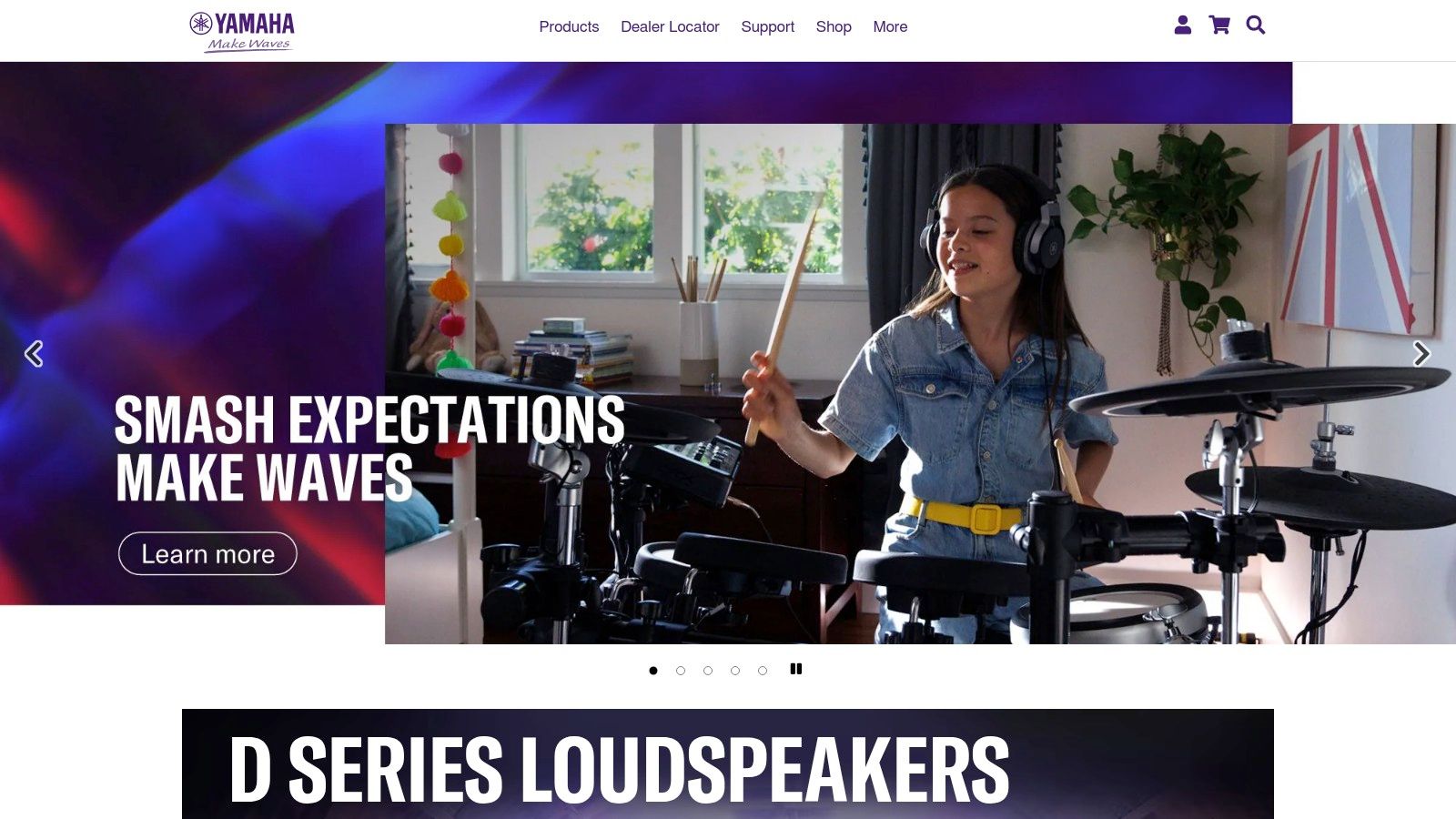
At the heart of the HS8's performance lies its bi-amplified design. Dedicated amplifiers power the 8-inch white cone woofer (75W) and the 1-inch dome tweeter (45W), ensuring optimal performance from each driver. This results in a clear and defined sound across the frequency spectrum, with excellent transient response. The bi-amplified design also minimizes distortion, even at higher volumes, further contributing to the monitor's accurate sound reproduction. While some find this clinical sound beneficial, it may feel less "exciting" compared to studio monitors offering more low-end enhancement. The iconic white woofer, while aesthetically pleasing, does tend to show dust easily, requiring a little extra care.
For those seeking to optimize their home studio, understanding the technical requirements and placement of the HS8 is essential. The monitors feature both XLR and TRS inputs, providing flexibility in connecting to your audio interface. Room control and high trim response controls allow you to tailor the monitor's output to your specific acoustic environment, mitigating the impact of room reflections and achieving a more accurate listening experience. This is particularly important for smaller home studios where room acoustics can significantly impact the perceived sound. If you're unsure about how to best position your monitors or adjust the room control settings, you can Learn more about Yamaha HS8 and other related home recording topics. These resources can help you maximize the performance of your studio monitors and create a more professional sounding mix.
While the HS8 offers a solid low-end for its size, its bass response might not satisfy those working with bass-heavy genres like electronic music or hip-hop. In such cases, adding a subwoofer to your setup could extend the low-end and provide a more complete sonic picture. The HS8’s accurate reproduction might reveal weaknesses in a mix that more colored monitors would mask, leading to better overall mixing decisions in the long run. This accurate monitoring makes it easier to identify and correct issues related to frequency balance, stereo imaging, and dynamics. This is incredibly beneficial for intermediate creators refining their workflow and software skills, as well as musicians experimenting with AI-enhanced production tools, where precise sonic feedback is crucial.
The Yamaha HS8 delivers a combination of accuracy, build quality, and affordability that makes it a compelling option for anyone looking for the best home studio monitors. Although they might sound "clinical" to some and lack the deepest bass extension, their transparent sound reproduction is invaluable for making informed mix decisions. This, coupled with its robust construction and trusted reputation, solidifies the HS8's position as a leading choice for home studios across various genres and experience levels. While pricing can fluctuate, the HS8 generally offers good value for the performance it delivers, positioning it as a smart investment in your musical journey.
3. KRK Rokit 5 G4
The KRK Rokit 5 G4 consistently earns its spot among the best home studio monitors, especially for beginners and those working in smaller spaces. This 5-inch active studio monitor expertly balances affordability with professional-grade features, making it a popular choice for home studios where accurate sound reproduction is crucial without breaking the bank. Whether you're an aspiring music producer laying down your first tracks, a songwriter fine-tuning melodies, or an independent artist looking to elevate your home recordings, the Rokit 5 G4 offers a compelling solution for critical listening. Its combination of a detailed sound profile and user-friendly tuning capabilities allows you to create a more professional sonic environment, even in less-than-ideal room acoustics.
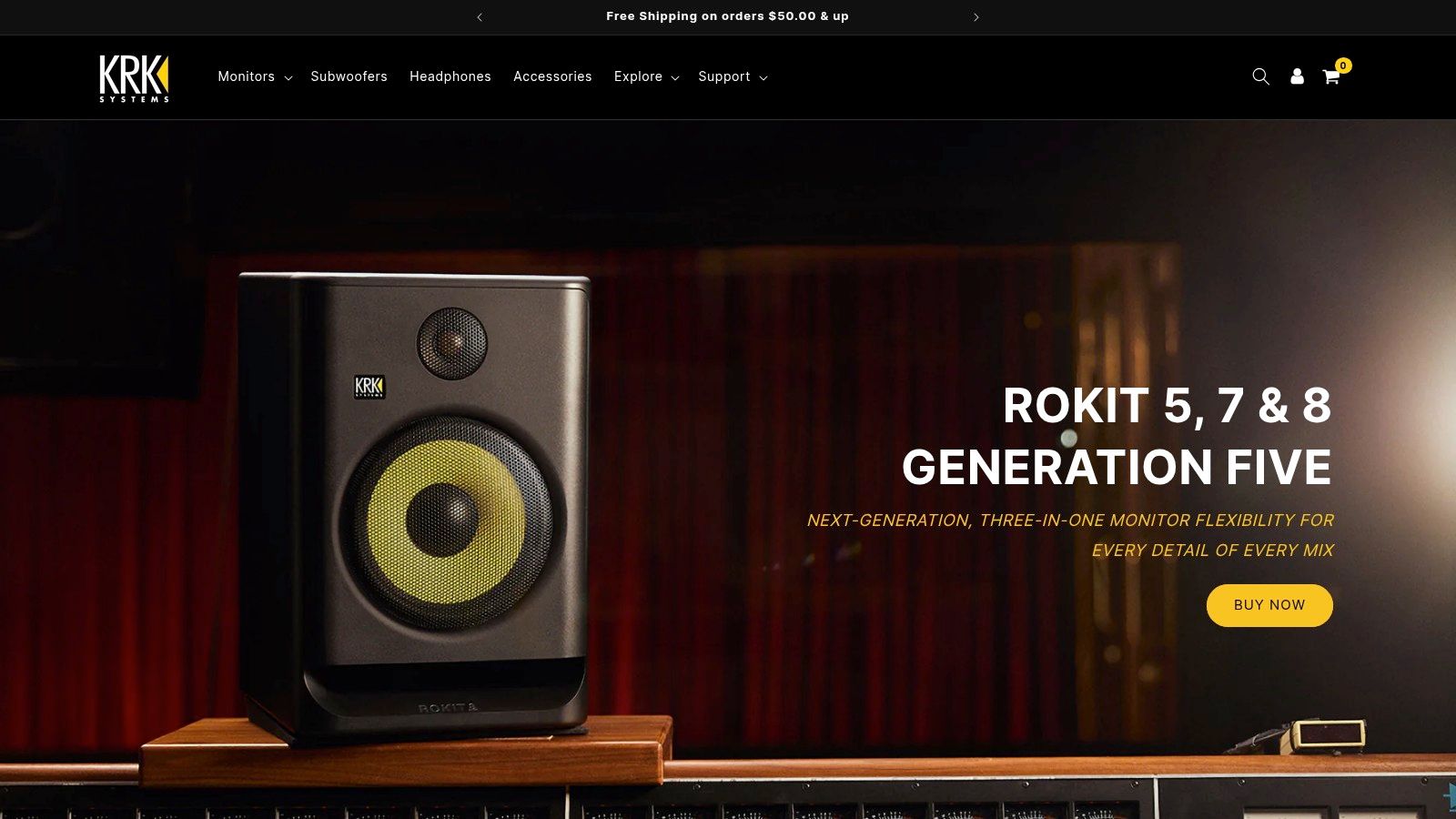
At the heart of the Rokit 5 G4's performance is its 5-inch Kevlar woofer and 1-inch silk dome tweeter. The Kevlar woofer delivers a tight, controlled low-end response, while the silk dome tweeter provides smooth and detailed high frequencies, creating a balanced and accurate soundstage ideal for mixing and mastering. This combination allows you to hear nuances in your music that might otherwise be missed, enabling more informed decisions during the production process. The Rokit 5 G4’s matching amplifiers (55W for the low-frequency driver and 20W for the high-frequency driver) ensure sufficient power for clear and dynamic sound reproduction, even at higher volumes.
A standout feature of the Rokit 5 G4 is its built-in LCD visual EQ display and DSP-driven room tuning. This functionality allows users to compensate for the acoustic imperfections of their listening environment. Using the onboard controls and visual feedback, you can adjust the monitor's frequency response to minimize the impact of room reflections and resonances, leading to a more accurate and reliable listening experience. This feature is particularly valuable in home studios where dedicated acoustic treatment might not be feasible. The visual EQ display offers 25 graphic EQ settings to mitigate common acoustic problems, providing a level of control rarely found in this price range.
Compared to similarly priced monitors like the Yamaha HS5 or the PreSonus Eris E5 XT, the KRK Rokit 5 G4 stands out with its user-friendly visual EQ and room correction system. While other monitors might offer comparable sound quality, the Rokit 5 G4’s ease of adjustment and customization makes it particularly attractive to those new to studio monitoring or working in less-than-perfect acoustic spaces.
Setting up the Rokit 5 G4 is straightforward. Simply connect them to your audio interface or other sound source using balanced TRS or XLR cables. Positioning is crucial for optimal performance. Place the monitors equidistant from your listening position, forming an equilateral triangle. Ideally, they should be positioned at ear level, angled slightly inwards towards the listener. Experiment with the placement and utilize the onboard EQ and room correction features to fine-tune the sound for your specific room.
While the Rokit 5 G4 offers excellent value, it's important to be aware of its limitations. The smaller 5-inch woofer, while suitable for most genres, might not deliver the deep bass extension required for bass-heavy music production. Some users also find the LCD display distracting, although it can be dimmed or turned off. The build quality, while generally acceptable, might not feel as robust as higher-end monitors. Finally, while the Rokit 5 G4 provides detailed sound for its price point, it might lack the ultimate clarity and precision of more expensive studio monitors.
Overall, the KRK Rokit 5 G4 provides an excellent entry point into the world of professional studio monitoring. Its combination of detailed sound reproduction, user-friendly room correction, and affordable price makes it one of the best home studio monitors available, especially for those starting their journey in music production. You can find more information and technical specifications on the official KRK website: https://www.krkmusic.com
4. Focal Alpha 80 Evo
The Focal Alpha 80 Evo secures its spot on this list of best home studio monitors thanks to its impressive blend of professional-grade performance and user-friendly design. It's a robust choice for serious home studio producers, delivering a detailed and dynamic soundstage that allows for accurate mixing and mastering. These monitors are engineered to translate your mixes effectively, ensuring your music sounds its best across various playback systems. This makes them a worthwhile investment for aspiring music producers, beginner songwriters, independent artists, and anyone looking to elevate their home studio setup. Whether you’re crafting memorable lyrics, optimizing your workflow, or experimenting with AI-enhanced production, the Alpha 80 Evo provides a reliable sonic foundation.
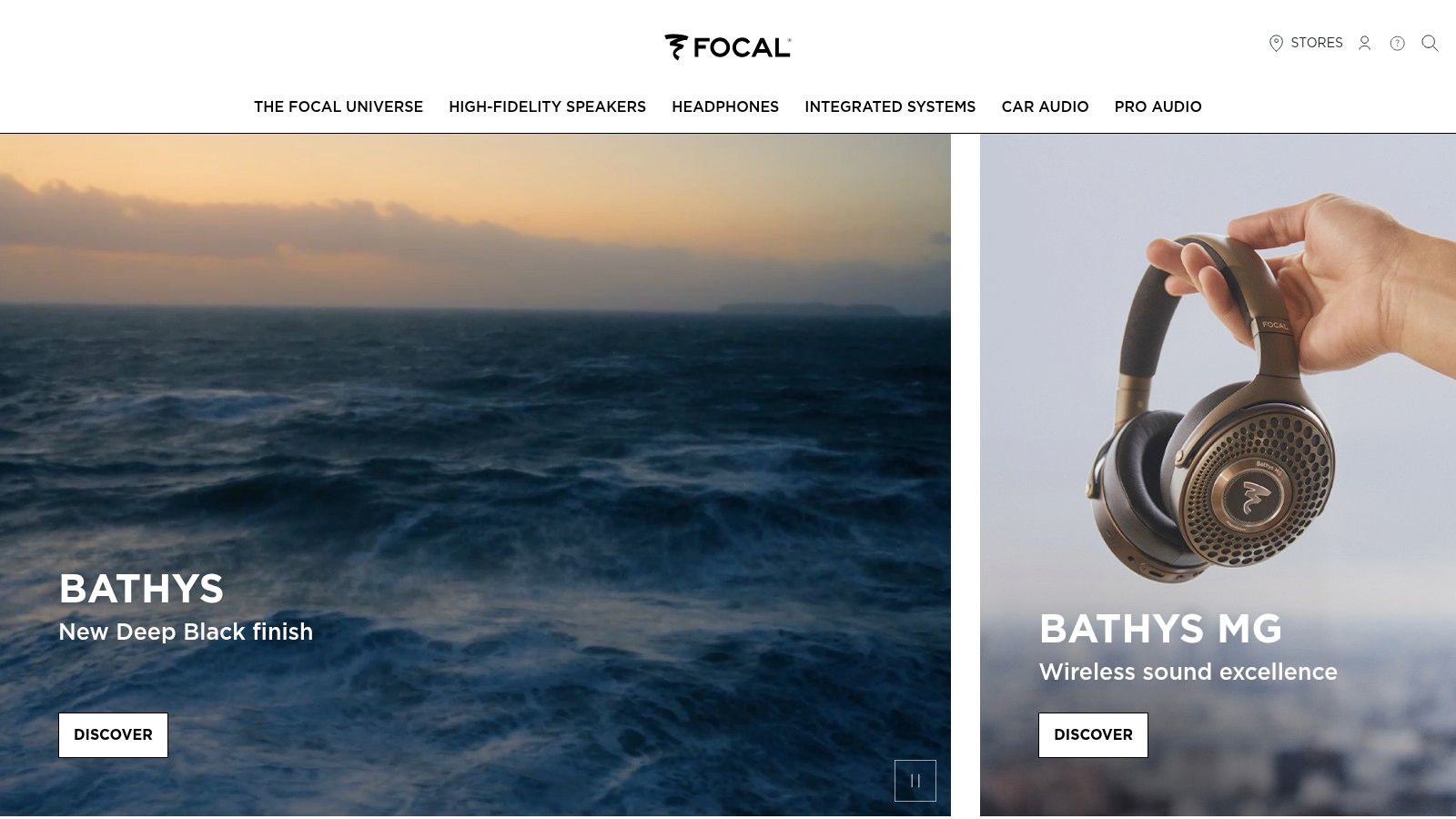
At the heart of the Alpha 80 Evo lies an 8-inch polyglass woofer, responsible for delivering a tight and controlled low-end response. This is paired with Focal's signature 1-inch aluminum inverted dome tweeter, renowned for its detailed and transparent high-frequency reproduction. This combination translates to a clear and well-defined midrange, crucial for accurately hearing vocals and instruments within a mix. The optimized amplification (70W for the woofer and 35W for the tweeter) ensures sufficient power to drive these components effectively, resulting in a dynamic and impactful listening experience.
One of the standout features of the Alpha 80 Evo is its build quality. Focal's commitment to professional French engineering is evident in the solid construction and robust components used in these monitors. This translates to not just durability, but also a more refined sonic performance. The absence of a faceplate around the tweeter also contributes to a more open and airy soundstage, allowing for greater detail and accuracy in high frequencies. Further enhancing its practicality, the automatic standby function helps conserve energy when the monitors are not in use. Multiple input options provide flexibility for connecting various audio sources, catering to diverse studio setups.
While the Alpha 80 Evo excels in many areas, it’s important to consider its limitations. The higher price point might be a barrier for some home studio owners, especially those just starting. Additionally, achieving optimal performance may require careful positioning within your listening environment. Unlike some newer monitors, the Alpha 80 Evo offers limited room correction features. This means users may need to invest in acoustic treatment to mitigate the impact of their room's acoustics on the sound. Finally, the accurate and revealing nature of these monitors can be a double-edged sword. While they excel at reproducing high-quality recordings, they can also be unforgiving, exposing flaws and imperfections in poorly recorded audio. Learn more about Focal Alpha 80 Evo and audio mixing techniques to maximize your results.
Compared to smaller nearfield monitors, the Alpha 80 Evo’s 8-inch woofer provides a more extended low-frequency response, beneficial for genres like electronic music and hip-hop where accurate bass reproduction is essential. However, for smaller studios or those working primarily with vocals and acoustic instruments, a smaller monitor might be sufficient.
When setting up your Alpha 80 Evos, consider placing them on stands at ear level, forming an equilateral triangle with your listening position. This helps create a balanced stereo image and ensures accurate monitoring. Experiment with different placements and angles to find the sweet spot in your room. If you’re aiming to achieve professional-level mixes with these best home studio monitors, investing in acoustic treatment, like bass traps and absorption panels, is highly recommended to minimize room reflections and achieve a more accurate sound.
For those seeking high-fidelity sound reproduction and accurate monitoring in their home studio, the Focal Alpha 80 Evo represents a significant step up. While the investment might be higher, the professional-grade performance and robust build quality make them a worthwhile investment for serious music creators. They deliver a level of detail and clarity that can significantly impact your mixing and mastering workflow. You can explore the Focal Alpha 80 Evo and its specifications further on the Focal website.
5. JBL 308P MkII
The JBL 308P MkII secures its spot on our list of best home studio monitors thanks to its impressive blend of professional-grade performance and affordability. These 8-inch powered studio monitors are a solid choice for both aspiring and seasoned musicians looking for accurate sound reproduction without breaking the bank. They offer a compelling combination of JBL's renowned audio engineering and features designed for critical listening, making them an excellent investment for enhancing your home studio setup. Whether you're laying down tracks, mixing, or mastering, the 308P MkIIs deliver the clarity and detail you need to make informed decisions about your music.

At the heart of the 308P MkII's performance lies JBL's patented Image Control Waveguide. This innovative technology ensures a wide and detailed sweet spot, allowing you to move around your listening position without experiencing drastic changes in the stereo image. This is crucial for accurate mixing and mastering, enabling you to make confident decisions about your music’s balance and spatial positioning. The waveguide works in conjunction with the 1-inch soft-dome tweeter to deliver crisp and clear high frequencies, free from harshness or distortion.
The low-end is handled by a robust 8-inch low-frequency transducer, coupled with JBL's innovative Slip Stream port design. This combination produces a tight and controlled bass response, extending down to the lower frequencies without muddiness. The Slip Stream port minimizes port turbulence, which can introduce unwanted distortions, ensuring a clean and accurate low-frequency reproduction. This makes the 308P MkII suitable for a variety of genres, from electronic music with deep basslines to acoustic recordings requiring subtle low-end nuances.
Powering these transducers is a Class-D amplifier, providing 56W to the woofer and 28W to the tweeter. This ensures ample headroom for most home studio environments, allowing the monitors to reproduce transients accurately and maintain clarity at higher volumes. While not the most powerful amplifiers on the market, they are more than adequate for nearfield monitoring in a typical home studio setting.
For aspiring music producers and songwriters, the JBL 308P MkII offers a valuable tool for honing their craft. The accurate frequency response helps identify areas for improvement in their mixes, enabling them to create professional-sounding recordings. Beginner songwriters can benefit from the clarity and detail offered by these monitors, allowing them to critically evaluate their vocal performances and instrumental arrangements.
The 308P MkII's straightforward setup is another advantage for home studio users. Simply connect them to your audio interface using balanced XLR or ¼-inch TRS cables, and you’re ready to go. While they lack advanced connectivity options like digital inputs, this streamlined approach keeps the setup simple and focused on the core monitoring function. The compact size also makes them suitable for smaller studios where desk space is at a premium.
While the JBL 308P MkII excels in many areas, it's essential to be aware of its limitations. The monitors offer limited room adjustment options, primarily a sensitivity switch for adjusting the input level. This can be a drawback for users in acoustically challenging rooms where more extensive EQ controls are necessary. They also have a relatively basic feature set compared to some higher-end monitors, lacking features like built-in DSP or advanced connectivity. Some users might find the sound signature slightly analytical and lacking in character, preferring a more colored sound for creative applications.
Pricing for the JBL 308P MkII typically falls in the mid-range category for studio monitors, making them an excellent value for their performance. (Please consult a retailer for up-to-date pricing). These monitors compete with offerings from brands like Yamaha HS series and KRK Rokit series, providing a compelling alternative with JBL's signature sound and build quality.
In conclusion, the JBL 308P MkII deserves its place among the best home studio monitors due to its balanced performance, accessible price point, and professional pedigree. While they may lack some advanced features found in more expensive models, their core strengths lie in accurate sound reproduction and a robust build. They are an excellent choice for musicians, producers, and songwriters seeking a reliable and affordable monitoring solution for their home studios. You can find more information and technical specifications on the official JBL website: https://jblpro.com
6. Genelec 8030C
When discussing the best home studio monitors, the Genelec 8030C consistently earns a spot at the top. These compact two-way active monitors, hailing from the renowned Finnish manufacturer Genelec, represent a significant investment in audio accuracy. They might not be the cheapest option, but their performance justifies the price tag for serious producers seeking a pristine listening experience. The 8030Cs are designed for nearfield monitoring, meaning they excel in smaller spaces like home studios, providing detailed and transparent sound reproduction that allows you to make critical mixing decisions with confidence.

At the heart of the 8030C's performance lies Genelec's proprietary Directivity Control Waveguide (DCW) technology. Integrated with the 5-inch woofer, the DCW ensures a controlled dispersion pattern, minimizing unwanted reflections and creating a remarkably focused sweet spot. This results in exceptionally accurate stereo imaging, allowing you to pinpoint the placement of instruments within the mix with incredible precision. Paired with the 0.75-inch metal dome tweeter, the 8030C delivers a balanced and detailed frequency response, crucial for everything from sculpting nuanced vocals to crafting impactful drum tracks.
While the 5-inch woofer performs admirably, the 8030C’s bass extension is understandably limited compared to larger monitors. If you primarily produce bass-heavy genres like hip-hop or electronic music, you might consider supplementing them with a dedicated subwoofer. However, for most genres, including pop, rock, folk, and acoustic music, the 8030C's low-end reproduction is remarkably accurate and well-defined, providing ample information for balanced mixes. Learn more about Genelec 8030C and other studio monitor options. This article offers valuable insights into choosing the right monitors for your specific needs.
The 8030C also shines in its adaptability to different room acoustics. Integrated room response compensation controls allow you to fine-tune the monitor's performance to compensate for the unique characteristics of your listening environment, mitigating issues like unwanted bass buildup or reflections. These controls empower you to achieve a flatter frequency response, translating to more accurate mixes that translate well across different playback systems.
Genelec's legendary build quality is evident in every aspect of the 8030C. From the robust cabinet construction to the high-quality components, these monitors are built to last. The included Iso-Pod isolation mounting system further enhances performance by decoupling the monitors from the surface they're placed on, minimizing vibrations and further improving clarity.
While the exceptional accuracy and transparency of the 8030C are highly valued by professional engineers worldwide, this “clinical” sound might not appeal to all users. Some might find the presentation less forgiving, revealing imperfections in the source material. Indeed, the 8030Cs demand high-quality audio sources to truly shine. They unveil the nuances of your recordings, both good and bad.
Another significant factor is the price. The Genelec 8030C sits at the higher end of the price spectrum for home studio monitors of this size. Aspiring producers working with tight budgets might find the cost prohibitive. However, for those who prioritize accuracy, reliability, and long-term investment, the 8030C represents a valuable addition to their studio setup. If you're searching for best home studio monitors, and your budget allows, these monitors are definitely worth considering. They deliver a level of detail and transparency that can significantly elevate your mixing and mastering process.
7. Presonus Eris E8 XT
For those seeking a compelling blend of accuracy, affordability, and flexible features amongst the best home studio monitors, the Presonus Eris E8 XT emerges as a strong contender. These 8-inch active studio monitors aim to deliver a detailed sonic picture without breaking the bank, making them particularly appealing to home studio owners, aspiring producers, and musicians seeking a solid upgrade from basic listening setups. They offer a compelling entry point into the world of professional-grade monitoring, providing crucial tools for crafting and refining your sound.

The Eris E8 XT’s 8-inch Kevlar woofer handles the low-end frequencies, delivering a robust and defined bass response crucial for genres like electronic music, hip-hop, and rock. Meanwhile, the 1.25-inch silk dome tweeter takes care of the high frequencies, providing clarity and detail without harshness, which is vital for mixing vocals, acoustic instruments, and other delicate sonic elements. This combination offers a balanced frequency response that allows you to accurately assess your mix and make informed decisions during production.
A standout feature of the Eris E8 XT is its comprehensive set of acoustic tuning controls. These controls go beyond the standard high and low frequency adjustments typically found in this price range. The inclusion of a dedicated midrange focus control allows for nuanced tweaking of the critical midrange frequencies where the majority of instruments and vocals reside. This level of control empowers you to compensate for room acoustics and personal listening preferences, resulting in a more accurate and tailored listening experience. Further refining the acoustic tailoring are additional controls for adjusting low-cut filters and acoustic space settings.
The Eris E8 XT shines in its connectivity options. Offering XLR, TRS (balanced and unbalanced), and RCA inputs, these monitors accommodate a wide range of audio interfaces, mixers, and other studio gear. This versatility simplifies setup and integration into existing or future home studio configurations, whether you're using a professional audio interface or connecting directly from a computer's sound card.
While the Eris E8 XT provides excellent value, it's important to acknowledge its limitations. The plastic construction, while robust enough for home studio use, doesn't quite match the premium feel of higher-end monitors. Also, the brand recognition of Presonus, while growing, still lags behind industry giants like Yamaha or KRK in the professional audio world. Some users have also noted that the midrange, despite dedicated controls, can sometimes sound slightly colored. However, considering the accessible price point, these are generally minor trade-offs for the features and performance offered.
Compared to similarly priced monitors like the Yamaha HS8 or the KRK Rokit 8 G4, the Eris E8 XT holds its own with a competitive feature set and a more affordable price tag. The Yamaha HS8 is known for its neutral sound signature, while the KRK Rokit 8 G4 boasts a more forward and modern sound. The Eris E8 XT occupies a space between these two, offering a slightly warmer sound than the Yamaha HS8 but not as aggressively sculpted as the KRK Rokit 8 G4.
Setting up the Eris E8 XT is straightforward. Simply connect your audio source to the appropriate inputs, position the monitors equidistant from your listening position, and fine-tune the acoustic controls to compensate for your room’s characteristics. For optimal performance, consider investing in acoustic treatment for your room to minimize reflections and improve overall accuracy. While pricing can vary depending on the retailer, the Presonus Eris E8 XT typically falls within a price range that makes them one of the best home studio monitors for budget-conscious creators. These monitors present a substantial upgrade over standard computer speakers and provide a solid foundation for crafting, mixing, and mastering your music. They represent a valuable investment for any aspiring or intermediate music producer, songwriter, or independent artist looking to elevate their home studio setup. The website, https://www.presonus.com, offers further details and specifications.
8. Neumann KH 120 II
For those seeking the pinnacle of accuracy and detail in their home studio monitoring setup, the Neumann KH 120 II demands serious consideration. While its premium price point might seem daunting, its performance within a properly treated acoustic environment justifies its inclusion amongst the best home studio monitors available. These monitors are designed for discerning ears and are an investment in truly professional-grade sound reproduction. If you’re serious about mixing and mastering your music to the highest standards, the KH 120 II offers a level of precision that is hard to match.
The KH 120 II builds upon the legacy of Neumann’s renowned studio monitor heritage, incorporating cutting-edge DSP technology and refined acoustic engineering into a compact form factor. This combination allows the KH 120 II to deliver an incredibly detailed and transparent soundstage, unveiling subtle nuances in your mixes that might be lost on lesser monitors. The 5.25-inch long-throw woofer and 1-inch fabric dome tweeter work in perfect harmony, producing a balanced frequency response across the audible spectrum. While the compact size limits the bass extension compared to larger monitors, the low-end delivered is remarkably tight and controlled, avoiding the muddiness that can plague some smaller speakers. This precision allows you to make informed mixing decisions, especially regarding low-end instruments like bass guitar and kick drums.
One of the standout features of the KH 120 II is its advanced DSP-based room adaptation. This technology helps compensate for the acoustic imperfections of your listening environment, mitigating the negative impact of reflections and standing waves. While acoustic treatment is always recommended, the KH 120 II’s DSP provides an additional layer of correction, ensuring a more accurate representation of your mix regardless of room characteristics. This is particularly beneficial for home studios where perfect acoustic conditions are often difficult to achieve.
The KH 120 II is designed to work seamlessly with Neumann’s MA 1 automatic monitor alignment system. While the monitors themselves offer significant sonic benefits, pairing them with the MA 1 unlocks their full potential. The MA 1 uses a calibrated microphone and sophisticated algorithms to analyze your room’s acoustics and automatically adjust the KH 120 II’s DSP parameters for optimal performance. This automated process eliminates the guesswork often involved in manual monitor calibration, ensuring the most accurate and consistent listening experience possible. While the MA 1 adds to the overall cost, it represents a worthwhile investment for those seeking the absolute best from their KH 120 IIs.
For aspiring music producers striving for professional-quality mixes, the KH 120 II offers an unparalleled level of accuracy. Beginner songwriters can benefit from the clear and detailed soundstage, enabling them to craft more nuanced and emotionally resonant compositions. Independent artists optimizing their home studio setups will appreciate the compact size and powerful performance of the KH 120 II, making it a space-saving solution without compromising on quality.
Compared to other best home studio monitors in its price range, such as the Barefoot Sound Footprint01 or the Genelec 8341A, the Neumann KH 120 II offers a distinct sonic signature characterized by its analytical detail and transparency. While the others may offer more robust bass extension or different voicing characteristics, the KH 120 II's precision and clarity make it a top contender for critical listening and mixing applications.
Setting up the KH 120 II is straightforward. Connect them to your audio interface using balanced XLR cables for optimal signal integrity. Position the monitors on stands at ear level, forming an equilateral triangle with your listening position. Once connected, you can access the onboard DSP controls for basic room adaptation. For the most refined setup, utilizing the MA 1 automatic alignment system is highly recommended.
However, the KH 120 II does come with some caveats. The most significant is the price, with a pair costing upwards of $1,800. This can be a significant investment, especially for beginners. For basic home studios with less stringent requirements, the KH 120 II might be overkill. Additionally, realizing the full potential of these monitors necessitates the purchase of the MA 1 system, further adding to the cost. Finally, while the bass response is impressive for its size, it won't match the low-end extension of larger monitors, potentially requiring the addition of a subwoofer for bass-heavy genres.
Despite these considerations, the Neumann KH 120 II remains a top choice among professional and aspiring engineers. Its exceptional accuracy, advanced DSP features, and premium build quality make it a worthwhile investment for those seeking the best possible sound reproduction in their home studios. You can find more information and technical specifications on the official Neumann website: https://en-us.neumann.com
Top 8 Home Studio Monitors Comparison
| Monitor Model | Core Features & Tech ✨ | Sound Quality ★★★★☆ | Target Audience 👥 | Unique Selling Points 🏆 | Price & Value 💰 |
|---|---|---|---|---|---|
| Adam Audio A7V | X-ART tweeter, 7" Carbon fiber woofer, DSP room adaptation | Exceptional clarity ★★★★★ | Pro mixers / mastering | Proprietary tweeter, flexible inputs, waveguide tech ✨ | Premium ~$1,500+ / pair 💰 |
| Yamaha HS8 | 8" white cone woofer, bi-amped, room & trim controls | Accurate, uncolored ★★★★☆ | Home producers & pros | Legendary HS series, trusted worldwide 🏆 | Mid-range, good value 💰 |
| KRK Rokit 5 G4 | 5" Kevlar woofer, LCD EQ display, DSP room tuning | Good detail ★★★☆☆ | Beginners & home studios | Built-in room correction, LCD EQ display ✨ | Affordable, budget-friendly 💰 |
| Focal Alpha 80 Evo | 8" polyglass woofer, aluminum inverted dome tweeter | Clear & dynamic ★★★★☆ | Home studios & semi-pros | French engineering, automatic standby | Higher priced 💰 |
| JBL 308P MkII | 8" woofer, soft dome tweeter, Image Control Waveguide | Smooth response ★★★★☆ | Entry-level to pro home studios | Patented waveguide design | Mid-range, good value 💰 |
| Genelec 8030C | 5" woofer, DCW tech, room compensation controls | Neutral & accurate ★★★★★ | Professional & demanding users | Superior imaging & build quality 🏆 | Expensive for size 💰 |
| Presonus Eris E8 XT | 8" Kevlar woofer, silk dome tweeter, acoustic tuning | Solid for price ★★★☆☆ | Budget-conscious home studios | Midrange focus, versatile inputs | Affordable 💰 |
| Neumann KH 120 II | 5.25" woofer, advanced DSP, MA 1 room alignment | Premium detail ★★★★★ | Pro & professional home studios | DSP with room adaptation, compact premium design 🏆 | Very expensive ~$1,800+ 💰 |
Hear the Difference: Investing in Quality Sound
Choosing the right studio monitors is paramount for any serious music creator. From the crisp highs of the Adam Audio A7V to the powerful lows of the Yamaha HS8, and the budget-friendly KRK Rokit 5 G4 to the high-end precision of the Neumann KH 120 II, finding the best home studio monitors for your needs will dramatically impact your mixing and mastering process. We've explored a range of options, including industry standards like the Focal Alpha 80 Evo, JBL 308P MkII, Genelec 8030C, and Presonus Eris E8 XT, each offering unique sonic characteristics and features. Remember to consider your room size, budget, and the genre of music you primarily work with when making your decision. Accurate sound reproduction is the cornerstone of a professional-sounding mix, allowing you to make informed decisions about EQ, compression, and other crucial production elements. Investing in a quality pair of best home studio monitors is an investment in the clarity, depth, and overall impact of your music.
By understanding the strengths of each model and considering your individual requirements, you can transform your home studio into a truly professional workspace. Whether you’re an aspiring producer, songwriter, or seasoned musician, having the right tools is crucial. Taking the time to find the best home studio monitors for your specific needs will undoubtedly elevate your productions to the next level.
Want to explore more tools and resources to enhance your music production workflow? ChordX offers a wealth of information and AI-powered tools to help you create, learn, and connect with other musicians. Visit ChordX today and discover how you can further optimize your studio setup and unlock your full creative potential.
